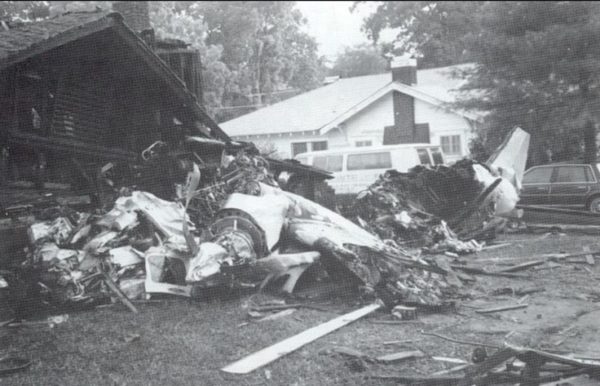Alabama’s Deadliest Commercial Air Accident: On This Date in 1991

At 4:05 p.m., At 4:05 p.m., L’Express Flight 508 took off from New Orleans International Airport bound for Mobile. The eventual destination of the Beech C99 aircraft was Birmingham. It left Mobile at 5:05 p.m. with thirteen passengers, the Captain, and First Officer. The Terminal Forecast for Birmingham indicated the possibility of thunderstorms, but the flight was uneventful. At 5:45 p.m., as the crew began its approach into the Birmingham area, the weather officer contacted the controllers at the airport and informed them that Level 3 and 4 thunderstorms extended from near the Vulcan VOR, a navigational aid west-northwest of Birmingham to near Gadsden. The activity was pushing southeast. At 5:51 p.m., the pilot asked the controllers at Atlanta Center for permission to deviate around a thunderstorm buildup that was in their path.
At 5:55 p.m., a strong thunderstorm moved across the field at the Birmingham Airport. The tower made an announcement to all flights that a low-level wind shear advisory was in effect. A Lear Jet on approach decided to cancel its approach and wait. At 6:00 p.m., the Atlanta Center handed off L’Express 508 to Birmingham approach control. The south radar controller acknowledged the plane and gave it permission to descend. At that time, a Piper Aerostar was on final approach to runway 5, using an instrument approach. At 6:01, the Lear asked controllers how the Piper’s inbound ride was going. The Aero reported no problems.
At 6:03, the BHM controller advised LEX 508 that the Lear had canceled its approach. The Captain told the First Officer to advise the passengers that their landing might be delayed. At 6:05 p.m., the pilots of the Piper Aero reported that the ride had not been that bad during their landing. One minute later, the crew of LES 508 decided they would attempt the landing based on the report from the Piper. At 6:08, LEX 508 was advised to stay on the approach frequency in case they decided to abort. After replying “okay,” the Captain told the First Officer, who was handling the plane, to watch out for wind shear.
At 6 p.m., on July 10, 1991, L’Express Airlines Flight 508 was making its approach to runway 5 at the Birmingham International Airport. The flight from New Orleans had been smooth and uneventful, but as passengers looked through the open cockpit door, through the windshield they could see the inky black sky of a thunderstorm directly in their path. They wondered aloud to each other if the crew was going to fly through the storm or go around it. In the cockpit, the Captain had given control of the aircraft momentarily to the First Officer so that he could consult a chart.
At 6:09, the transcript of the cockpit voice recorder tape indicated that the Captain told the First Officer that if he didn’t feel comfortable flying the plane during the landing to let him know. He also told him to look out for wind shear. Soon, the sound of very heavy rain can be heard hitting the windshield. Shortly thereafter, the BHM controller asked LEX 508 how the ride was. “Okay, so far,” was the response. Just before 6:11, Birmingham Approach told LEX 508 to contact the tower for landing. It would be the last radio transmission from the doomed flight.
On the ground in Ensley, several witnesses saw the plane as it flew over. They reported that very heavy rain, frequent lightning, and winds strong enough to bed trees over to the grounds were occurring. One witness reported that the plane appeared to be struck by lightning. Several witnesses gave erratic reports about engine sounds. Seconds later, the Captain called for climb power. On the tape, the sound of the engines increasing can be heard. Suddenly, the plane lifted up and to the right. The Captain exclaimed, “What are you doing?” Then he realized that the upset was not due to anything the First Officer was doing. The plane then banked severely to the left, with the wings becoming nearly vertical.
On the morning of July 11, 1991, members of the National Transportation Safety Board were in Birmingham to investigate the crash of L’Express flight 508. The Beech C99 commuter aircraft had gone down on approach to Birmingham during a thunderstorm at approximately 6:12 p.m. CDT. The Captain and one passenger were the only survivors. The First Officer and twelve other passengers were killed in the crash. It is still the deadliest commercial aviation accident in Alabama history.
The investigators combined information from the cockpit voice recorder, interviews with the survivors and controllers and weather records. The safety board expressed concerns about the Captain’s fatigue level since he was flying the third of four flight legs scheduled for him that day. The fact that he had been on duty nearly fourteen hours led to concerns that he might have chosen to fly through the storm because he had been on duty so long. The investigators found that weather information was accurate and that the crew was properly informed about the storm. The fact that another plane had just landed through the storm concerned the investigators because a similarly sudden and violent unexpected motion like LEX508 experience could have just as easily have happened to the first plane.
In the end, the NTSB decided that the probable cause of the L’Express crash was the decision of the Captain to initiate and continue an instrument approach into clearly identified thunderstorm activity, resulting in a loss of control of the aircraft from which the crew was unable to recover and subsequent collision with obstacles and terrain.
Category: ALL POSTS, Met 101/Weather History


















